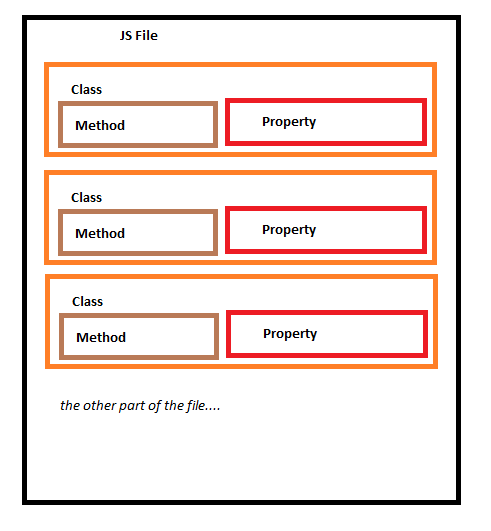Introduction
What is OOP?
Object Oriented Programming is a way to manage functions and variables without having to create like tons of functions with prefixes that you have to remember.
In a logical way of explaining this, OOP supports data structures consisting of properties and methods,
basically it's a way to group variables and functions. Since the Simula programming language, many dynamic
programming languages have started to implement it too (e.g., C, C++); JS/EcmaScript is the first web-based programming language that supports OOP.
Classes

You manage your functions and variables in classes. Just remember this, whenever I say "object", I mean class, Object is equivalent to Class.
Creating our first object
1st way: Defining our object
To create an object in JS, you do it almost like in Perl:
var my_obj = {};
Note that my_obj is the object's name.
These parentheses will contain our object's method & properties.
Adding some methods and properties
Methods
Methods are like functions, so you need to write an anonymous function inside the curly braces:
someMethod: function(){ document.write("something"); }
Note: someMethod is the Method's name
You can also do: your object name + dot (.) + prototype + dot(.) = the property's name.
my_obj.prototype.someProperty = function(){ document.write("something"); };
Note that function() is not enclosed with the parentheses.
Properties
Properties are variables, to create it do this inside the curly braces:
someProperty: "someValue"
Note: someProperty is the property's name, someValue is the property's value
You can also do: your object name + dot (.) + prototype + dot(.) = the property's name as seen above.
my_obj.prototype.someProperty = "someValue";
Warning: When you're done with a method or a property in the parentheses, place a colon at the end of it if it's not the final method/property.
Constructors
Constructors are the second way to load an object with the developers arguments.
function me(sp,sm){
this.someMethod=sm;
this.someProperty =sp;
}We're gonna make a duplicate the my_obj as seen above
var my_obj = new me("something", function(){ document.write("somemethod") } )
Initialize our object
We do not need to create an instance of our object. All we need to do now is access your object's methods/properties. Let's look at
two examples using our object.
Example 1 (Property):
To access a property, type in your object name + dot (.) + the property's name.
document.write(my_obj.someProperty);
Example 2 (Method):
To access a property, type in your object name + dot (.) + the property's name.
my_obj.someMethod();
Putting it together
Now that we have a complete object set-up, it's time to write the files!
JS
var my_obj = {
someMethod: function(){ document.write("something"); },
someProperty: "someValue"
};
document.write(my_obj.someProperty + "<br>");
my_obj.someMethod();
JS (using constructors)
function me(sp,sm){
this.someMethod=sm;
this.someProperty =sp;
}
var my_obj = new me("something", function(){ document.write("somemethod") }
document.write(my_obj.someProperty + "<br>");
my_obj.someMethod();
HTML
<script src='obj.js'></script>
